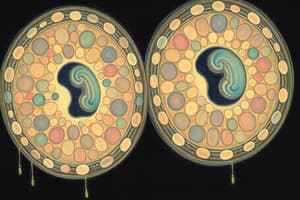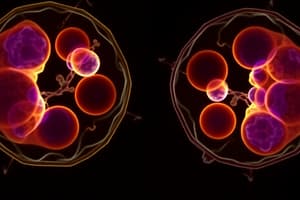Podcast
Questions and Answers
What occurs when cells break away and invade other tissues?
What occurs when cells break away and invade other tissues?
- Angiogenesis
- Hyperplasia
- Metastasis (correct)
- Apoptosis
What is the main reason for stopping the cell cycle when DNA is damaged?
What is the main reason for stopping the cell cycle when DNA is damaged?
- To allow for further mutations
- To initiate apoptosis
- To promote faster cell division
- To prevent incorrect cellular messages (correct)
Before a cell can divide, what must happen to its DNA?
Before a cell can divide, what must happen to its DNA?
- It must become fragmented
- It must remain intact
- It must duplicate itself (correct)
- It must mutate
What is the process by which prokaryotic cells reproduce asexually?
What is the process by which prokaryotic cells reproduce asexually?
What is a key characteristic of daughter cells produced by binary fission?
What is a key characteristic of daughter cells produced by binary fission?
What is the primary purpose of interphase in cell division?
What is the primary purpose of interphase in cell division?
During which phase of mitosis do the chromosomes line up in the center of the cell?
During which phase of mitosis do the chromosomes line up in the center of the cell?
Which statement about sister chromatids is true?
Which statement about sister chromatids is true?
What occurs during telophase and cytokinesis?
What occurs during telophase and cytokinesis?
Which of the following best describes the difference between somatic cells and gametes?
Which of the following best describes the difference between somatic cells and gametes?
What is the primary purpose of cell division in multicellular organisms?
What is the primary purpose of cell division in multicellular organisms?
What percentage of a cell’s life is spent in interphase?
What percentage of a cell’s life is spent in interphase?
Which phase of the cell cycle involves DNA replication?
Which phase of the cell cycle involves DNA replication?
Which checkpoint is responsible for assessing the cell’s size and nutrient availability before DNA synthesis?
Which checkpoint is responsible for assessing the cell’s size and nutrient availability before DNA synthesis?
What occurs during the G2 phase of the cell cycle?
What occurs during the G2 phase of the cell cycle?
What characterizes malignant tumor cells?
What characterizes malignant tumor cells?
What is considered a tumor?
What is considered a tumor?
Which statement about the G2 checkpoint is true?
Which statement about the G2 checkpoint is true?
What type of cells are produced at the end of meiosis?
What type of cells are produced at the end of meiosis?
During which phase of meiosis do homologous chromosomes line up at the center of the cell?
During which phase of meiosis do homologous chromosomes line up at the center of the cell?
What is the primary purpose of meiosis?
What is the primary purpose of meiosis?
Which of the following correctly describes the outcome of meiosis?
Which of the following correctly describes the outcome of meiosis?
During which stage of meiosis do the daughter cells become haploid?
During which stage of meiosis do the daughter cells become haploid?
Why is it essential for gametes to be haploid?
Why is it essential for gametes to be haploid?
What occurs during Anaphase I of meiosis?
What occurs during Anaphase I of meiosis?
What is the main distinction between meiosis and mitosis?
What is the main distinction between meiosis and mitosis?
Flashcards are hidden until you start studying
Study Notes
The Cell Cycle
- Cell cycle: a sequence of events in a eukaryotic cell's life, from origin to division into two daughter cells.
- Cells divide for two reasons: reproduction of the organism and growth/repair of cells in a multicellular organism.
Stages of the Cell Cycle
- Interphase: The longest stage of a cell’s life (90%), where the cell performs its normal functions and prepares for division.
- Cell Division (Mitosis): The final stage of a cell's life cycle, where DNA is duplicated and divided into daughter cells.
Interphase
- G1 phase (gap 1): The first phase after a cell divides, where it takes in nutrients, produces proteins, and grows.
- S phase (synthesis): DNA is replicated during this phase, resulting in twice the amount of DNA in the cell.
- G2 phase (gap 2): Occurs after the S phase and before cell division. The cell prepares for division by ensuring raw materials are available.
Cell Cycle Checkpoints
- G1 Checkpoint: Stops the cell cycle if the cell is too small, lacks sufficient nutrients, or if DNA is damaged.
- G2 Checkpoint: Stops the cell cycle if the cell is too small, lacks sufficient nutrients, DNA is damaged, or chromosome duplication in the S phase is incomplete.
Tumors
- A mass of cells created by rapid, uncontrolled cell division.
- Often occur when cells ignore cell cycle checkpoints.
- Benign tumors: Cells remain confined to one site.
- Malignant tumors (cancerous): Cells become anchorage-independent, invading other tissues to form metastases.
- Metastases: Spread of cancer from one organ to another.
- Angiogenesis: Formation of new blood vessels, promoted by cancerous cells.
DNA
- The genetic blueprint containing the information for cells to function properly.
- Located within the nucleus of eukaryotic cells.
- Must be duplicated before a cell can divide.
Cell Division
- The final stage of a cell's life cycle, where DNA is duplicated and divided into daughter cells.
Cell Division in Prokaryotes
- Binary fission: Asexual reproduction process in prokaryotes and some single-celled eukaryotes.
- The cell copies its chromosome.
- Chromosomes move to separate ends of the cell.
- The cell splits into two daughter cells, each receiving one chromosome.
- Daughter cells are genetically identical clones.
Cell Division in Eukaryotes
- Mitosis: Asexual reproduction in somatic (body) cells that produces two identical daughter cells.
Mitosis: Stages
- Prophase: Chromosomes condense, the nuclear membrane dissolves, and the spindle forms.
- Metaphase: Chromosomes line up in the center of the cell.
- Anaphase: Spindle fibers pull chromatids apart, and chromatids migrate to opposite poles of the cell.
- Telophase/Cytokinesis: The nuclear membrane reforms, and the cell pinches in two, forming two daughter cells.
DNA Synthesis
- During Interphase's 'S' phase, DNA replicates.
- The cell has two identical copies of each chromosome, called sister chromatids.
- Sister chromatids are held together by a centromere.
Meiosis: Overview
- Cell division used in sexual reproduction to produce sperm and egg cells (gametes).
- Gametes are haploid, containing only one copy of each chromosome.
- Somatic cells are diploid, possessing two copies of each chromosome.
Gamete Formation
- Sperm are formed in the testes.
- Eggs are formed in the ovaries.
- Gametes are produced by meiosis.
Human Chromosomes
- Humans have 46 chromosomes organized into 23 homologous pairs (one from each parent).
- Meiosis halves the number of chromosomes, starting with a diploid cell and ending with four haploid cells.
Meiosis I: The First Round of Cell Division
- Interphase: Growth and chromosome replication.
- Prophase I: Chromosomes condense, the nuclear membrane dissolves, and the spindle forms.
- Metaphase I: Homologous chromosomes line up in the center of the cell.
- Anaphase I: Homologous chromosomes separate to opposite poles.
- Telophase I/Cytokinesis: Nuclear membranes form, and the cell pinches in two, resulting in two haploid daughter cells.
Meiosis II: The Second Round of Cell Division
- Prophase II: Chromosomes attach to the spindle.
- Metaphase II: Chromosomes line up in the center of the cell.
- Anaphase II: Sister chromatids of each chromosome separate.
- Telophase II/Cytokinesis: Nuclear membrane reforms, and the cell pinches in two, resulting in four haploid daughter cells.
Key Differences Between Mitosis and Meiosis
- Mitosis: Produces two identical diploid daughter cells.
- Meiosis: Produces four unique haploid daughter cells.
Importance of Haploid Gametes
- They provide the correct number of chromosomes for a new organism when a sperm cell fertilizes an egg cell, ensuring a diploid organism.
Studying That Suits You
Use AI to generate personalized quizzes and flashcards to suit your learning preferences.



